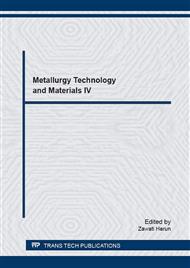p.3
p.8
p.14
p.19
p.24
p.29
p.34
p.39
Composition, Microstructure and Properties of Ultra-High-Strength Steel for Offshore Structural Application
Abstract:
In this paper, first, based on the employing environment and properties requirement of offshore platform, the influence of various alloying elements on the performance of steel was analyzed and chemical composition of a new ultra-high-strength alloy steel was designed. Then, the designed alloy steel specimen has been prepared using intermediate frequency induction furnace. Austenization temperature of the steel was determined through thermal dilatometer. The effects of quenching and tempering process on microstructure and mechanical properties of the steel were studied by means of optical microscopy (OM), scanning electron microscopy (SEM), durometer and universal material tensile tester. The research results indicated that the casting microstructure of the designed steel was a duplex structure of martensite and acicular bainite. The austenitizing onset temperature (Ac1) and termination temperature (Ac3) was 700°C and 790°C, respectively. With the increase of the austenitizing temperature, the hardness of the steel first increased until it reached the maximum value at 860°C and then decreased above 860°C. Meanwhile, the hardness of the steel decreased with the increasing of the tempering temperature in the range 150°C-500°C. The optimal heat-treatment processes were concluded as follows: heating up to 860°C, quenching by oil, and then tempering at 170°C. The superior mechanical properties of tensile strength of 1400MPa and elongation of 6.5% as well as the microstructure of tempered martensite were obtained after this heat treatment.
Info:
Periodical:
Pages:
8-13
Citation:
Online since:
August 2016
Authors:
Keywords:
Price:
Сopyright:
© 2016 Trans Tech Publications Ltd. All Rights Reserved
Share:
Citation:


